Some daily events in the changing sky for April 16 – 24.
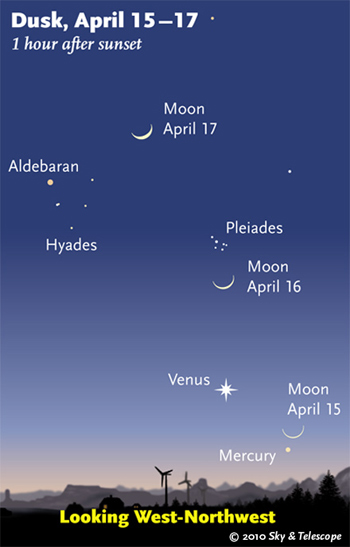
Venus and the crescent Moon draw attention to several less obvious sights in the western twilight. (These scenes are always drawn for the middle of North America. European observers: move each Moon symbol a quarter of the way toward the one for the previous date. For clarity, the Moon is shown three times actual size.)
S&T
Friday, April 16
Saturday, April 17
Sunday, April 18
Monday, April 19
Tuesday, April 20
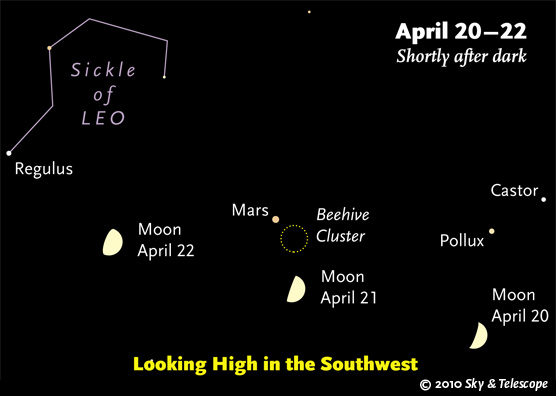
Waxing further as the week progresses, the Moon passes beneath Castor, Pollux, Mars, and Regulus.
Sky & Telescope diagram
Wednesday, April 21
Thursday, April 22
Friday, April 23
Saturday, April 24
Want to become a better amateur astronomer? Learn your way around the constellations. They're the key to locating everything fainter and deeper to hunt with binoculars or a telescope.

The Pocket Sky Atlas plots 30,796 stars to magnitude 7.6 — which may sound like a lot, but that's less than one star in an entire telescopic field of view, on average. By comparison, Sky Atlas 2000.0 plots 81,312 stars to magnitude 8.5, typically one or two stars per telescopic field. Both atlases include many hundreds of deep-sky targets — galaxies, star clusters, and nebulae — to hunt among the stars.
Sky & Telescope
For an easy-to-use constellation guide covering the whole evening sky, use the big monthly map in the center of each issue of Sky & Telescope, the essential magazine of astronomy. Or download our free Getting Started in Astronomy booklet (which only has bimonthly maps).
Once you get a telescope, to put it to good use you must have a detailed, large-scale sky atlas (set of charts). The standards are the Pocket Sky Atlas, which shows stars to magnitude 7.6; the larger Sky Atlas 2000.0 (stars to magnitude 8.5); and the even larger and deeper Uranometria 2000.0 (stars to magnitude 9.75).
You'll also need good deep-sky guidebooks, such as Sky Atlas 2000.0 Companion by Strong and Sinnott, or the more detailed and descriptive Night Sky Observer's Guide by Kepple and Sanner, or the classic if somewhat dated Burnham's Celestial Handbook. Read how to use your charts effectively.
Can a computerized telescope take their place? I don't think so — not for beginners, anyway (and especially not on mounts that are less than top-quality mechanically). As Terence Dickinson and Alan Dyer say in their Backyard Astronomer's Guide, "A full appreciation of the universe cannot come without developing the skills to find things in the sky and understanding how the sky works. This knowledge comes only by spending time under the stars with star maps in hand."
This Week's Planet Roundup
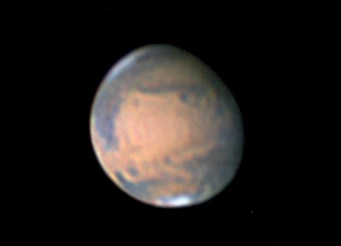
Mars's north polar cap (bottom) is shrinking fast now in the late spring of the Martian northern hemisphere. Note the dark division that has appeared in the cap. Dark Syrtis Major is near the left limb, Sinus Sabaeus stretches above center, and three-pronged Sinus Meridiani is upper right of center.
Gibbous Mars was only 8.0 arcseconds in diameter when Damian Peach in England took this extraordinary image on April 17th, using a 14-inch Schmidt-Cassegrain scope and a SKYnyx 2-0 video camera. Stacked-video images like this usually show much more detail than the eye can see even in the same telescope.
Mercury is fading and dropping out of sight in the sunset, after pairing with Venus for the first half of April.
Venus (magnitude –3.9) shines brightly in the west-northwest during twilight, becoming a little higher and more obvious every week. It will climb higher in May and June but not by very much (for observers at mid-northern latitudes). Then it will gradually sink back down for the rest of the summer.
Mars, dimming into the distance at magnitude +0.5, shines very high in the southwest during evening. It's in Cancer, left of Pollux and Castor and above Procyon. Near it binoculars show the big Beehive Star Cluster, M44.
In a telescope, Mars is gibbous and shrinking: from 8.0 to 7.5 arcseconds in diameter this week. Can you still see its north polar cap? The cap is shrinking as the Sun rises higher on it in the late spring of Mars's northern hemisphere.
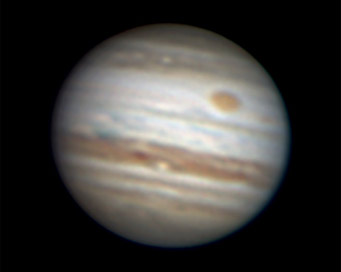
Jupiter's South Equatorial Belt had practically disappeared by the time Jupiter sank into the sunset last February, and it's still gone now that Jupiter is reappearing in the dawn. In a small telescope, Jupiter is one-belted! John Wesley in Australia took this image on April 12th at 19:50 UT, when the central-meridian longitude was 120° (System II). South is upper right.
Jupiter (magnitude –2.1) is low in the dawn. Look for it above the eastern horizon about 45 minutes before your local sunrise time. Nothing else there is nearly so bright.
Saturn (magnitude +0.7, in the head of Virgo) is high in the southeast to south during evening. In a telescope Saturn's rings are tilted only 2.2° from edge-on. They'll narrow to 1.7° from mid-May through early June, then begin widening again. Now's a fine time to try for the more difficult of Saturn's moons with your telescope; see the May Sky & Telescope, page 61, and the April issue, page 47.
Uranus and Neptune are still in the glow of sunrise.
Neptune, however, is passing a historic milestone this month. For the first time since the planet was discovered in 1846, it has completed a full circuit of the sky and has returned very close to the point (near the Aquarius-Capricornus border) where Johann Galle first spotted it from Berlin Observatory on September 23rd of that year — following a prediction of its existence by Urbain Le Verrier based on its perturbations of Uranus. See The Return of Neptune.
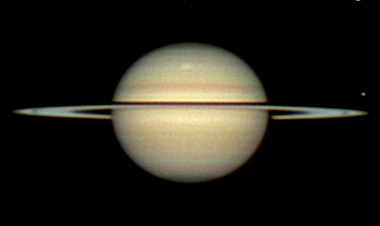
The Saturn Electrostatic Disturbance (SED) white spot was back when Christopher Go took this image on April 11th (at 13:50 UT; the spot is near System III longitude 15°), but by the 19th it had faded again. South is up. The satellite at right is Tethys.
Also note the dark reddish South Equatorial Belt, the bright Equatorial Zone, and the thin black line of the rings' shadow on the globe. The rings were tilted 2.5° to Earth's line of sight but 3.7° to the incoming sunlight. This disparity is what allows us to see the rings' shadow. It began in mid-March and will increase slightly in the next few weeks, making the shadow-line a little wider and more prominent.
http://saturn.cstoneind.com/
Pluto (magnitude 14, in northwestern Sagittarius) is highest in the south before dawn.
All descriptions that relate to your horizon or zenith — including the words up, down, right, and left — are written for the world's mid-northern latitudes. Descriptions that also depend on longitude (mainly Moon positions) are for North America. Eastern Daylight Time (EDT) equals Universal Time (also known as UT, UTC, or GMT) minus 4 hours.
To be sure to get the current Sky at a Glance, bookmark this URL:
http://SkyandTelescope.com/observing/ataglance?1=1
If pictures fail to load, refresh the page. If they still fail to load, change the 1 at the end of the URL to any other character and try again.
 0
0
Comments
You must be logged in to post a comment.